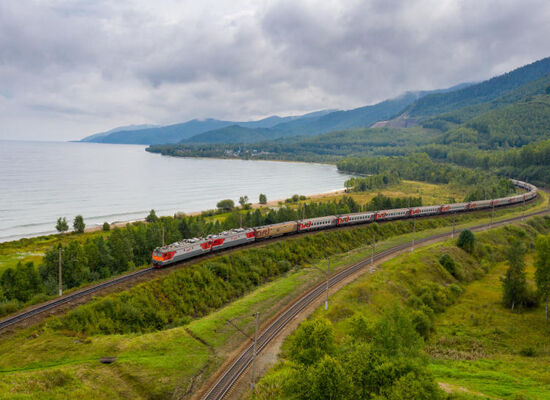Moscow to Vladivostok Trains
Learn about the longest train journey on Earth
Moscow to Vladivostok Train Route
A journey on the Trans-Siberian Railway is the longest train journey on Earth. During 6-7 days on the train, you can see the endless pine forests, mighty rivers and rolling plains of the Russian landscape.
As of 2021, only two trains operate on Moscow to Vladivostok route, one of which is the famous Rossiya train. The same trains run on the Vladivostok to Moscow route. Electronic tickets are available on both routes, making your travel arrangements quick and easy.
Moscow to Vladivostok Train Tickets
based on 59 customer reviews
Frequently Asked Questions From Our Travelers
It takes 7 days if you travel non stop. The distance between Moscow and Vladivostok is 9,289 km.
The price largely varies with the season and level of comfort you choose. You get the lowest price, approx $120, if you travel in 3rd class from October to February. If you prefer travelling in summer in a 1st class cabin, each ticket will cost you approximately $1000 or more. Also, you get the lowest price if you book your tickets well in advance, more than 90 days before the trip.
Russian trains are basically safe. Train corridors are patrolled by conductors and a police officer; train compartments are equipped with locks and also doors can be chained from the inside. When you travel, use common sense, keep your documents and money close to yourself and don't accept alcohol or any drinks from strangers.
In fact, there's no such train called "The Trans-Siberian Express". Trans-Siberian is the name of the train route from Moscow to Vladivostok the longest train route in the world. At the moment there are 2 trains covering the entire distance: the famous branded train #001/002 Rossiya and a regular passenger train #061/062
The distance between Moscow and Vladivostok is 9,289-kilometer. The non-stop Moscow - Vladivostok train trip takes 6 days.
The train stops for 3-5 minutes in small towns and for 20-50 minutes in larger cities. There is not enough time for sightseeing, you can only go out of the train to walk along the platform or to buy some instant food or drinks from the station kiosks.
Yes, most of the trains offer men-only, women-only and mixed 1st class and 2nd class cabins.
Some of the Moscow to Vladivostok trains have showers on board. You can use them for a small fee, approx $5. Please ask the conductor if a shower is available.
There are three ticket types available on Moscow to Vladivostok trains, all of them come with sleeping berths. A 1st class ticket is a cabin for 2 passengers, there are 2 lower sleeping berths. 2nd class cabins have 2 lower and 2 upper berths, 3rd class doesn’t have any closed cabins, the car has 54 sleeping berths. All berths come with bed linen, pillows and blankets.
Testimonials
“
Booked several trips with RussianRail
I have used RussianRail for six legs of a trip from Vladivostock to Astana and each time the web booking system has been efficient and simple to navigate. Additionally I had occasion to communicate with the office to investigate possibilities and the responses have been immediate and courteous. I only wish that I was able to book my train travel from Kazakhstan onwards with them as the KZ site is hopeless compared to Russianrail. I certainly have no problem in recommending RR.
“
Great service - highly recommended
We used Russian Rail to book the second leg of our Trans Siberian journey, going from Irkutsk to Vladivostok on the 002 Rossiya. The booking process was seamless. What really impressed us was that they refunded us a considerable amount when the exchange rate had changed in our favour on the day of booking. Thank you, Russian Rail, for your honesty and integrity. We would not hesitate to recommend you to other rail users.
“
Booked several trips with RussianRail
I have used RussianRail for six legs of a trip from Vladivostock to Astana and each time the web booking system has been efficient and simple to navigate. Additionally I had occasion to communicate with the office to investigate possibilities and the responses have been immediate and courteous. I only wish that I was able to book my train travel from Kazakhstan onwards with them as the KZ site is hopeless compared to Russianrail. I certainly have no problem in recommending RR.
“
Booking through your company made our life easier
Booking through your company made our life easier when organising such a complex trip from our perspective. Communication was excellent and to break the trip into four parts from Beijing/Ulaan Baatar/Urkutsk/Moscow/St Petersburg this was essential. We would recommend tour company.
“
Perfectly on track
Russian Rail made booking my entire Trans-Siberian adventure incredibly simple. Navigating a foreign system can seem intimidatingly opaque, not least with an unfamiliar alphabet and remote stations, but Russian Rail made it transparent. The site provided complete clarity and therefore complete freedom to choose the times, cabins, and stops that I wanted, even at the last minute. The booking process was easy and swift. Fantastic!
“
One of the best trips I've been on
It was one of the best trips I've been on. The train ride, the people and the views. It is a must do. Thank you for helping me with my booking and making the reservation process simple.
The History of Trans-Siberian Railway
Introduction
The Trans-Siberian Railway is a complex, multiroute railway; it also happens to be the record holder for the longest railway in the world! It should come as no surprise that the railway’s main route begins in Russia's capital, Moscow. From Moscow, the Trans-Siberian Railways heads east, where it ends in Vladivostok. The Moscow to Vladivostok train route is also one of the most beautiful train journeys on earth. This isn’t the only route the railway makes, however.
- The Trans-Mongolian Line: As the name implies, the Trans-Mongolian Line travels through Mongolia before ending in Beijing. Construction on this line began in 1940 and ended in 1956. This train offers the unique experience of carrying travelers through the Gobi desert, filled with sand dunes and dramatic mountains. The route is 7867 kilometers.
- The Trans-Manchurian Line remains part of the Trans-Siberian until it reaches Tarskaya. From here, the Trans-Manchurian Line makes its way to China, and finally to Beijing. Traveling this way, the journey from Moscow to Beijing is an astounding 9001 kilometers!
- The Baikal Amur Magistral (BAM) began in 1984. To say this is the one of the most complex routes in the system is an understatement. The 3843-kilometer-long BAM begins in Taishet and goes all the way north to Khabarovsk, where it meets the Pacific Ocean. Due to the complexity of the BAM route, travelers may need to change trains or even get on a bus for part of their journey. The Trans-Siberian Railway does not promote this route, for that reason.
Photo on RZD.ru
The Trans-Siberian Railway: A Brief History
The Trans-Siberian Railway was created to help alleviate the issue of transporting goods (and people) across Russia, which is, after all, the world’s largest country. The project was ambitious, and proved to be hugely popular with Russian citizens. Unfortunately, however, construction was slow, and completing the project took far longer than anticipated.
Several decades after the railway was proposed, and after numerous delays in funding, in February 1891, construction finally started in both Chelyabinsk and Vladivostok. For the Russian people, the Trans-Siberian railway was a source of national pride.
Alexander III, the Emperor of Russia at the time, had far reaching ambitions for his country and immediately saw the economic benefit that the railway could bring. It didn’t take long for him to direct the construction of the Trans-Siberian all the way through the expansive, rugged Siberian terrain. He trusted this important task to his son Nikolay, and on May 31, 1891, the construction of the railway entered its next phase.
Overcoming the Odds
Construction was slow and plagued by delays. Russia’s unforgiving climate, particularly in Siberia, with its bitingly cold winters, rough terrain, powerful rivers, and dense mountainous areas, created numerous obstacles. Construction crews had to improvise as they went, even building bridges to cross canyons, in order to achieve their goals.
But these weren’t the only challenges. A project this large required thousands of laborers, and enormous amounts of money. To alleviate worker shortages, construction managers had to get creative. At one point, former prisoners were even enlisted to help build the railway.
The Russian people were determined, however, and the project was completed 12 years later. An incredible 7,500 kilometers of tracks were laid! Enough to bring Europe to the Pacific Ocean from Moscow to Vladivostok.

Photo on RZD.ru
Room for Improvement
As every growing economy knows, efficient transportation is key to moving goods and connecting with hard-to-reach consumers. Once the Trans-Siberian railway was complete, the impact was immediate. Towns once out of reach, were now accessible, and eager to participate in this new economy. Unfortunately, the railway was soon tested by the Russo-Japanese war. The increased pressure of wartime needs strained the railway’s ability to efficiently move people and goods.
After the war, it was determined that the trains needed improved capacity limits, and they needed to move across the country more quickly. Changing the rails from wood to metal allowed for more trains to travel at faster speeds throughout Russia.
The Trans-Sibrian Today
A Look to the Future
The one hundred year anniversary of the Trans-Siberian Railway in 2001 marked a momentous moment in the train’s history. As part of the celebrations, and to demonstrate the train’s continued relevance in the Russian economy, organizers arranged for goods to be shipped from Japan to Vladivostok, and then to continental Europe, by way of Germany.
Astoundingly, the experiment was an incredible success! The train transported the goods more quickly than a sea-faring cargo ship! This successful trial ultimately led to an increase in trade with countries like South Korea, who were impressed by the iconic train’s reliability and speed.
Meeting Modern Channenges
Like anything as incredibly large and complex as the Trans-Siberian railway, challenges abound, and increasing efficiency is key to a successful future. Today, a different kind of challenge has emerged, as Eastern shipping companies have blocked the Trans-Siberian from transporting goods between the two continents.
Unlike previous challenges that required engineering solutions, this solution requires a more nuanced, multinational approach. Leveraging existing relationships with South Korea, and other emerging regional economies could bring the stalemate to an end. The most challenging issue for leisure travelers is navigating border crossings on the western piece of the railway. (Take a look at our Travel Diary - An Insider's Guide to the Trans-Siberian).

Photo on RZD.ru
A Changing of the Guard
What began as Alexander III’s vision of uniting the riches of Siberia with the rest of Russia, via a powerful train that would one day be known as the Trans-Siberian, has turned into so much more. In today’s Russia, the Trans-Siberian has become as much a symbol of Russia as it has a way to transport goods, cargo, and people across the rugged landscape. Russian President Vladimir Putin even uses the train to travel to countries like North Korea, rather than flying.
After over a century in use, incredibly, the Trans-Siberian railway is as popular as ever with foreigners traveling within the country, and locals. It’s not impossible to think that the Trans-Siberian will one day, once again, become a transportation behemoth, a new Silk Road for the region, spreading economic growth along with it. For now, the Trans-Siberian railway’s relevance to Russia remains untouched. It continues to be a source of pride for the country, and a source of inspiration for the future.
Once you have your tickets, look forward to a wonderful, smooth
and enjoyable journey through the Russian countryside.
Buy your ticket safely and securely and then sit back
and enjoy the ride!
Recommended by
Our travel group under the names Express to Russia, Russian Rail and Trans-Europe Express has been recommended and/or accredited by:

A portion of your order goes to helping underprivileged Russian children.














